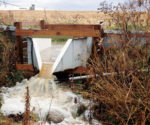Advertise Follow Us
Items Tagged with 'phosphorusrunoff'
ARTICLES
Timing, Placement and Soil Testing Key to Preventing Phosphorus Losses
Edge-of-field monitoring on 17 farms in Wisconsin and Minnesota highlights the need for no-tillers to apply ‘P’ under the soil surface and sample soils at varying depths.
Read More
6 Tips for Keeping ‘P’ in Fields and Out of Local Water Sources
While researchers find more phosphorus is leaving fields via tile, here’s what no-tillers can do to keep their fertility in their fields.
Read More
Scientists: Glyphosate Contributes to Phosphorus Runoff in Lake Erie
Low soil pH and certain metals are causing glyphosate to release phosphorus from the soil, which is responsible for about 25% of dissolved reactive phosphorus runoff in the Maumee watershed.
Read More







